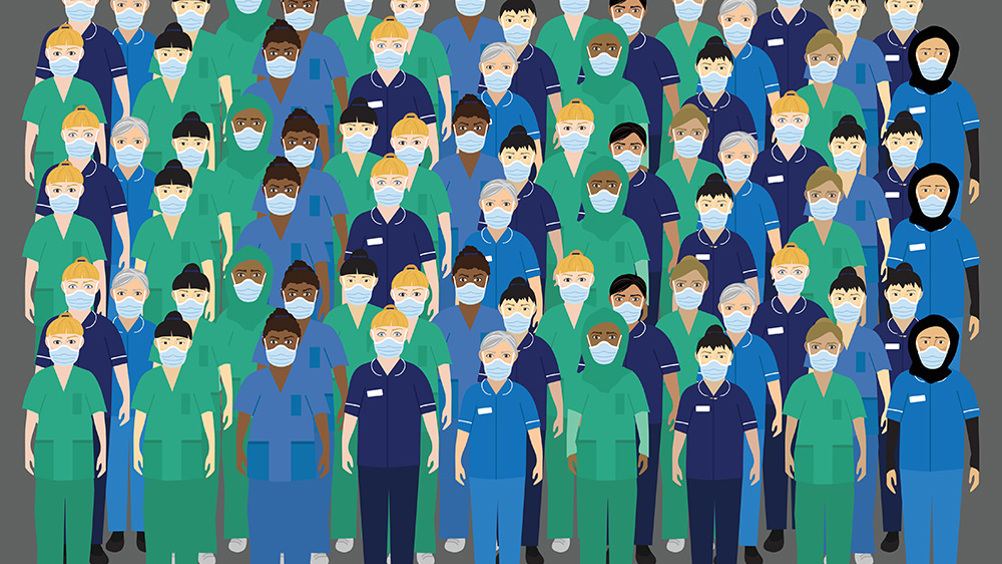June's roundup provided an overview of emerging guidelines on the management of patients presenting with symptoms of COVID-19 (Paterson, 2019). This month, we will evaluate research, information and guidelines around the involvement of the healthcare professional in the COVID-19 pandemic. There are many emerging studies looking at how the COVID-19 pandemic is impacting on healthcare staff's mental and emotional health and trying to prevent stress and distress.
Use of and access to personal protective equipment
Personal protective equipment (PPE) is at the heart of controlling the spread of the COVID-19 infection in hospitals and care setting, as well as the wearing of face masks in public spaces. The use and type of PPE required has been a subject of much debate. Little research existed around the effectiveness and adherence to PPE used in COVID-19. A cross-sectional study in Wuhan Province on the use of PPE by healthcare professionals reveals that procurement and use of appropriate PPE protected healthcare professionals from contracting the virus. The study involved 420 participants and focussed on doctors and nurses deployed to four hospitals in Wuhan, China, for 6–8 weeks during the peak of the country's pandemic between January and April. The participants were all involved in treating COVID-19 patients and undertook aerosol-generating procedures, having been provided with appropriate PPE and training on its use. The main outcome measures centred around the development of symptoms of the virus and swabbing for the virus, as well as antibody testing.
All participants tested negative for the virus and antibodies and reported no symptoms. The authors recommend that until an effective vaccine is found, the procurement of and training in appropriate PPE should be a top priority.
Psychological effects on healthcare workers
This Australian rapid review and meta-analysis sought to examine the psychological effects on clinicians working to manage novel viral outbreaks, and successful measures to manage stress and psychological distress. Studies were included in the analysis if they described psychological reactions of staff in a clinical setting during an outbreak of an emerging virus. A total of 59 papers were reviewed, covering SARS, Ebola, COVID-19, MERS and Influenza type A H1N1 and H7N9. In 38 of these studies, they compared psychological outcomes in workers who had direct clinical responsibility for infected patients, and 25 where high or low risk of exposure were compared. Outcome measures were psychological effects and the studies used tools to evaluate stress levels, psychological distress, and general health. Results indicated that staff in regular clinical contact with infected patients displayed higher levels of acute stress and post-traumatic stress than their lower exposure risk colleagues. Risk factors for those with the most severe levels of psychological distress were identified as youth, being junior in status, being a parent of dependent children or having an infected member in their family.
Other contributory factors were identified as time in quarantine (with more time leading to a more pronounced effect), lack of support (emotional and practical) and stigma. Positive aspects in helping avoid or minimise psychological distress were identified as good communication strategies, access to appropriate PPE, rest or reduced risk exposure and a heavy emphasis on the need for practical and emotional support measures to be in place. The authors conclude that effective interventions are available to minimise healthcare workers suffering psychological distress while engaging in their clinical duties in affected workplaces. They suggest that implementing the measures elucidated in the review, such as PPE, communication strategies and support would be transferable into mitigating psychological distress in the current COVID-19 pandemic.
Screening of healthcare workers
Concern has been expressed about the availability of, access to and uptake of COVID-19 screening in the healthcare population. A foundation trust in Newcastle implemented a COVID-19 screening programme in March 2020 for any workers who became symptomatic. The aims of introducing this programme of testing centred around staff health and welfare, identification and quarantining of infected individuals and to inform procedures and protocols regarding return of staff to work. The authors reflect on the rapidly changing landscape over the months since implementation and the need to adapt and respond to changes in guidelines and social distancing measure. They discuss the positive effects of good communication and team approaches. There is an acknowledgment of challenges in adopting these practices to avoid a sense of what they term as artificial prioritisation. They conclude that their early adoption of an inclusive swab policy appears to have been appropriate and review of data is being carried out to determine any further changes to the strategy as the pandemic evolves.
Conclusions
It is clear that as the pandemic reduces in severity and as we move towards a vaccine, reducing the number of new cases and having clearer guidelines on treatment and management of COVID-19 patients, some attention will turn to research into the effect of the pandemic on those in medical and healthcare professions.
Anecdotal evidence from healthcare professionals in the media and online forums suggest the psychological effects may be profound and interventions need to take place to mitigate against a rise in anxiety, depression and stress. Identifying the causes of stress and distress and using effective interventions as suggested in some of the papers reviewed this month seems to be key in promoting resilience in healthcare workers. It is incumbent upon policy makers and healthcare establishment management structures to be aware of the need to support and communicate with their staff now more than ever.


